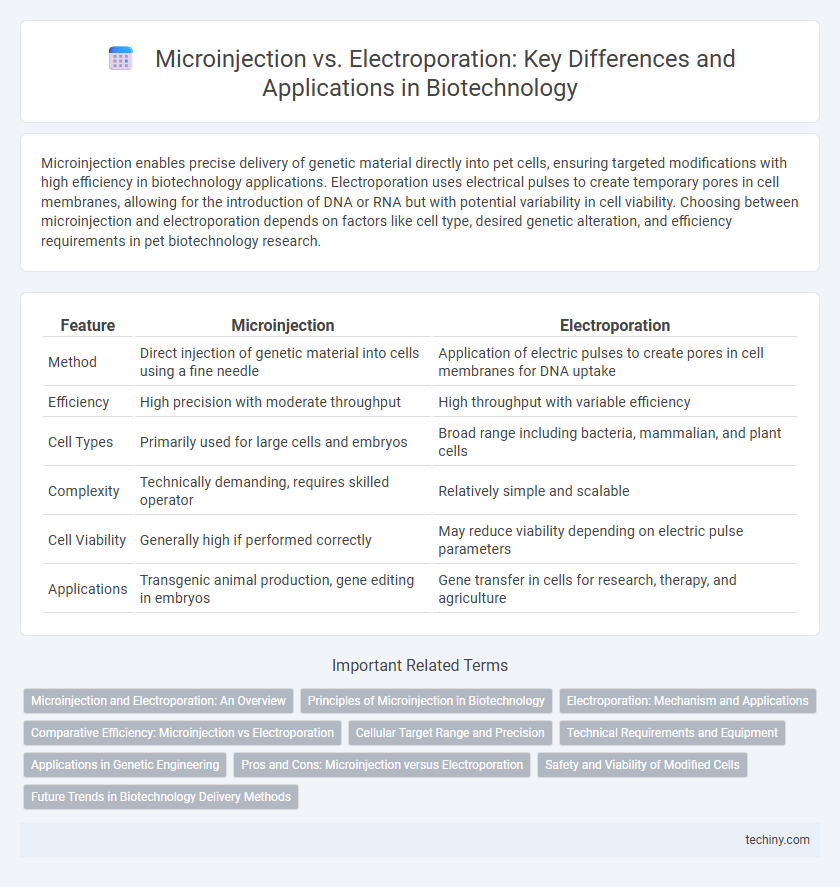Microinjection enables precise delivery of genetic material directly into pet cells, ensuring targeted modifications with high efficiency in biotechnology applications. Electroporation uses electrical pulses to create temporary pores in cell membranes, allowing for the introduction of DNA or RNA but with potential variability in cell viability. Choosing between microinjection and electroporation depends on factors like cell type, desired genetic alteration, and efficiency requirements in pet biotechnology research.
Table of Comparison
| Feature | Microinjection | Electroporation |
|---|---|---|
| Method | Direct injection of genetic material into cells using a fine needle | Application of electric pulses to create pores in cell membranes for DNA uptake |
| Efficiency | High precision with moderate throughput | High throughput with variable efficiency |
| Cell Types | Primarily used for large cells and embryos | Broad range including bacteria, mammalian, and plant cells |
| Complexity | Technically demanding, requires skilled operator | Relatively simple and scalable |
| Cell Viability | Generally high if performed correctly | May reduce viability depending on electric pulse parameters |
| Applications | Transgenic animal production, gene editing in embryos | Gene transfer in cells for research, therapy, and agriculture |
Microinjection and Electroporation: An Overview
Microinjection involves directly injecting genetic material into the cytoplasm or nucleus of a cell using a fine needle, allowing precise control over the introduction of DNA or RNA. Electroporation utilizes electric pulses to temporarily create pores in the cell membrane, facilitating the uptake of nucleic acids or other molecules into a wide variety of cells. Both techniques are widely employed in genetic engineering and cell biology for transfection, with microinjection offering high precision and electroporation providing scalability and efficiency across diverse cell types.
Principles of Microinjection in Biotechnology
Microinjection in biotechnology involves the precise delivery of nucleic acids or proteins directly into a single cell using a fine glass micropipette, enabling targeted gene editing or transgene expression. This technique relies on mechanical penetration of the cell membrane, minimizing cellular damage while allowing high-efficiency intracellular delivery. Microinjection is essential for applications requiring single-cell manipulation, such as creating transgenic animals or evaluating gene function at the cellular level.
Electroporation: Mechanism and Applications
Electroporation utilizes brief electrical pulses to create temporary pores in cell membranes, facilitating the introduction of DNA, RNA, or proteins into various cell types. This method is highly efficient for transfecting difficult-to-transfect cells such as neurons, stem cells, and bacteria, making it essential in genetic engineering, drug development, and regenerative medicine. Its applications extend to in vivo gene therapy, vaccine development, and CRISPR-mediated genome editing, where precision and high transfection rates enhance therapeutic outcomes.
Comparative Efficiency: Microinjection vs Electroporation
Microinjection demonstrates higher precision in delivering genetic material directly into individual cells, resulting in superior transfection efficiency for targeted cells. Electroporation offers broader application by simultaneously permeabilizing large cell populations, though its efficiency can vary depending on cell type and voltage parameters. Comparative studies reveal microinjection excels in single-cell accuracy, while electroporation is preferable for bulk cell treatments requiring rapid and scalable gene transfer.
Cellular Target Range and Precision
Microinjection offers unparalleled precision by directly delivering genetic material into individual cells, making it ideal for targeting specific cell types within heterogeneous populations. Electroporation provides a broader cellular target range by temporarily permeabilizing cell membranes with electric pulses, enabling simultaneous transfection of large cell populations, including difficult-to-transfect primary cells. The choice between microinjection and electroporation depends on experimental needs for precision versus throughput in genetic manipulation.
Technical Requirements and Equipment
Microinjection demands precise micromanipulators, microcapillary needles, and high-resolution microscopes to inject genetic material directly into cells, requiring skilled technicians and controlled environments. Electroporation utilizes specialized electroporators that generate calibrated electric pulses, cuvettes for sample placement, and conductivity-adjusted buffers to transiently permeabilize cell membranes for DNA uptake, emphasizing equipment calibration and cell type compatibility. Both methods necessitate stringent sterilization protocols and optimized parameters to maintain cell viability and transfection efficiency.
Applications in Genetic Engineering
Microinjection enables precise delivery of DNA or RNA directly into cells, making it ideal for creating transgenic animals and targeted gene editing in embryos. Electroporation uses electrical pulses to increase cell membrane permeability, efficiently introducing genetic material into bacterial, plant, and mammalian cells for a wide range of genetic modification applications. Both techniques play crucial roles in gene therapy development, functional genomics, and biopharmaceutical production.
Pros and Cons: Microinjection versus Electroporation
Microinjection offers precise delivery of genetic material directly into individual cells, allowing targeted manipulation with high accuracy but requires skilled operators and is time-consuming. Electroporation enables rapid, simultaneous transfection of large cell populations by applying electrical pulses to increase membrane permeability; however, it may cause higher cell mortality and less specificity. Balancing efficiency and cell viability is crucial when choosing between microinjection and electroporation for genetic engineering applications.
Safety and Viability of Modified Cells
Microinjection offers precise delivery of genetic material directly into cells, minimizing cell damage and ensuring high viability post-procedure. Electroporation uses electrical pulses to create temporary pores in cell membranes, which can cause increased stress and lower survival rates in sensitive cell types. Studies report microinjection maintains superior cell viability compared to electroporation, particularly in embryos and primary cells, making it a safer choice for delicate applications in biotechnology.
Future Trends in Biotechnology Delivery Methods
Microinjection and electroporation remain pivotal in biotechnology delivery methods, with future trends emphasizing enhanced precision and efficiency through automation and microfluidic integration. Advances in nanoparticle-assisted electroporation and CRISPR-Cas9 microinjection are expected to improve gene editing accuracy and reduce cellular damage. Emerging approaches aim to combine these techniques with real-time monitoring systems for optimized intracellular delivery in gene therapy and regenerative medicine.
Microinjection vs Electroporation Infographic

 techiny.com
techiny.com